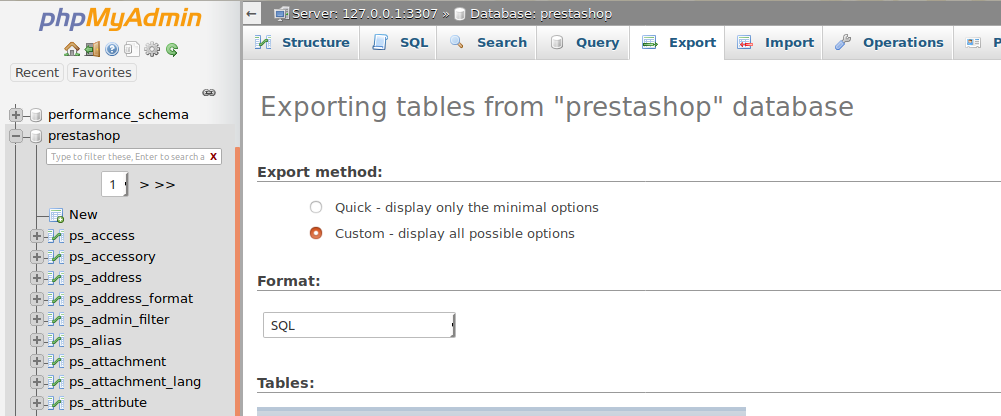Before starting anything, you must think first about safety. Any modification made to a shop could break it, so you must make sure all your data has been backed up before going further. This basically implies saving two things: your files and your database.
We will give you all the details you may need to run an upgrade, but we can’t be held responsible for any damage caused to your shop during the process. That’s why we strongly recommend you follow this backup step.
File backup
The first elements to backup are the files on the web server where you have deployed your PrestaShop. The PrestaShop folder not only contains the source code, but also your modules & themes, pictures, and all other resources needed to run your shop successfully.
Copy files
To complete this step, your shop folder must be copied somewhere else. Although it can be simply copied to another folder on your server, making an additional copy of your files on another computer is a nice additional security measure. To do so, connect to your server using an FTP, SSH, or RDP connection (depending on your server and hosting provider), copy the files to another location, then download them on your computer.
Note that depending on the number of files and your internet connection, this may take a few hours to complete. But if you’re an advanced user and have complete access to your server, the next part may help you go faster.
Bonus: Compress your files before download
As said before, downloading the whole PrestaShop folder one file at a time will take a long time to complete. If you can run commands on your server, you can make a backup faster by compressing the whole content in a single archive file, then downloading this file locally.
- On Windows-based servers, this requires remote desktop access. Once logged on to your remote environment, use Windows explorer to reach your www folder and compress all its content into a ZIP file.
- On Linux-based servers, you need to access your server terminal using SSH. Once logged in, reach your folder and use the following command to create a TAR file:
tar -czf <file_name>.tar <folder_to_save>
For instance:
tar -czf backup.tar /var/www/html
When your archive is ready, you may copy it on your computer.
Database backup
The database on which PrestaShop runs must be saved as well. There are many ways to get a dump of the database content, and we cannot cover all of them. Feel free to use your tools, we just cover the main ones here. You can consider your dump is complete when you get a SQL file with the structure AND the content of each table in it.
Using MySQL client in command line
Using mysqldump is the most straightforward way to make a full backup of a specific database. In a Windows or Linux terminal, run the following command to create a file dump.sql with your database structure & data:
mysqldump yourdbname > dump.sql
With yourdbname an example name for the PrestaShop database.
Your server is likely to require credentials. These details can also be provided as parameters:
mysqldump -h <IP_or_hostname> -u <user> --single-transaction --create-options -ecqQ -p db1 > dump.sql
If you do not remember your database name or credentials, you can find them in your configuration files:
- PrestaShop 1.6:
config/settings.inc.php - Since PrestaShop 1.7:
app/config/parameters.php
More details about backup & recoveries with MySQL binaries can be found in the official documentation.
[FREE MODULE] PrestaShop Database Management Tool Adminer
PhpMyAdmin (web interface)
PhpMyAdmin, provided by several hosting providers, offers another way to get a complete dump of your database.
Log on to your PhpMyAdmin interface, select the database where PrestaShop is installed, and chose the “export” tab.

Exporting a database in SQL format
We advise selecting the “custom” method, as it offers more options to customize your dump. Make sure all your tables, views, etc are selected for backup. To get the same file content as the mysqldump method, the following options should be checked as well:
- Use LOCK TABLES statement
- Add DROP TABLE / VIEW / PROCEDURE / FUNCTION / EVENT / TRIGGER statement
Click on “Go”, wait for the dump to be generated, then download it.
Other MySQL clients
There are a lot of ways to connect to a MySQL server. Much different software also provides a dump or export option as well.
- MySQL Workbench: https://dev.mysql.com/doc/workbench/en/wb-migration-wizard.html
- Navicat MySQL: https://www.navicat.com/manual/online_manual/en/navicat/win_manual/#/dump_execute_sql
- Adminer, a very easy-to-use and complete MySQL client in PHP: https://www.adminer.org/
- Sequel Pro (Mac): https://www.sequelpro.com/

